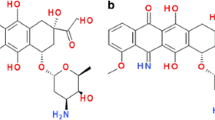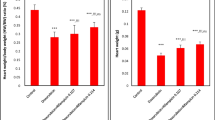Summary
Addition of morpholinomethyl substitutents to razoxane (ICRF-159) produced a compound (bis-4-morpholinomethyl-3,5-dioxopiperazinyl-1,2-propane (MM-159) considerably more water-soluble than razoxane. The increased solubility allowed MM-159 to be examined for protective activity against chronic doxorubicin (DXR) cardiotoxicity. Adult beagle dogs of either sex were given, i. v. at 3-week intervals, either DXR (1.75 mg/kg) alone or DXR 15 min after MM-159 (25 mg/kg). Control animals received MM-159 (25 mg/kg) or saline without DXR. The experiment was terminated 3 weeks after the ninth injection (total DXR dose, 15.75 mg/kg). Of the eight animals given DXR alone, five died after receiving seven to eight injections (12.25–14 mg/kg DXR) and the remaining three were killed after eight injections because they were in poor condition. Marked ascites was noted in four of these eight dogs. When frequency and extent of myocardial lesions (vacuolation and myofibrillar loss) were assessed on a scale from 0 to 4+, severe lesions (3+) were present in all eight dogs given DXR alone, but no abnormalities (lesion score 0) were found in the hearts of three of eight dogs given MM-159 and DXR and the five remaining animals in this group had minimal (1+; four dogs) or mild (2+; one dog) alterations. DXR reduced the erythrocyte count, hemoglobin, and hematocrit when administered alone, but not in combination with MM-159. Such protection against DXR hematologic effects was not noted previously [14] when dogs were pretreated with ICRF-187, the d-isomer of razoxane, despite the fact that pretreatment with ICRF-187 was as effective as MM-159 in reducing chronic DXR cardiotoxicity. It remains to be determined whether there are other differences in biological activity between MM-159 and ICRF-187.
Similar content being viewed by others
References
Billingham ME, Mason JW, Bristow MR, Daniels TR (1978) Anthracycline cardiomyopathy monitored by morphologic changes. Cancer Treat Rep 62: 865
Bristow MR, Billingham ME, Mason JW, Daniels TR (1978) Clinical spectrum of anthracycline antibiotic cardiotixity. Cancer Treat Rep 62: 873
Burke JF Jr., Laucius JF, Brodovsky HS, Soriano RZ (1978) Doxorubicin hydrochloride-associated renal failure. Arch Intern Med 137: 385
Camerman N, Hempel A, Camerman A (1984) Bimolane structure determination indicates anticancer activity is attributable to ICRF-154. Science 225: 1165
Creighton AM, Hellmann K, Whitecross S (1969) Antitumor activity in a series of bisdiketoperazines. Nature (London) 222: 384
Dawson KM (1975) Studies on the stability and cellular distribution of dioxopiperazines in cultured BHK-215 cells. Biochem Pharmacol 24: 2249
Hellmann K, Newton KA, Whitemore DN, Hanham IWF, Bond JV (1969) Preliminary clinical assessment of ICRF-159 in acute leukemia and lymphosarcoma. Br Med J 1: 822
Herman EH, Ferrans VJ (1981) Reduction of chronic doxorubicin cardiotoxicity in dogs by pretreatment with (+)-1,2-bis(3,5-dioxopiperazinyl-1-yl)propane (ICRF-187). Cancer Res 41: 3436
Herman EH, Ferrans VJ (1983) Influence of vitamin E and ICRF-187 on chronic doxorubicin cardiotoxicity in miniature swine. Lab Invest 49: 69
Herman EH, Mhatre RM, Chadwick DP (1974) Modification of some of the toxic effects of daunomoycin (NSC 82, 151) by pretreatment with the antineoplastic agent ICRF-159 (NSC 129, 943). Toxicol Appl Pharmacol 27: 517
Herman EH, Ardalan B, Bier C, Waravdekar V, Krop S (1979) Reduction of daunorubicin lethality and myocardial cellular alterations by pretreatment with ICRF-187 in Syrian golden hamsters. Cancer Treat Rep 63: 89
Herman EH, Ferrans VJ, Jordan W, Ardalan B (1981) Reduction of chronic daunorubicin cardiotoxicity by ICRF-187 in rabbits. Res Commun Chem Pathol Pharmacol 31: 85
Herman EH, Witiak DT, Hellmann K, Waravdekar VS (1982) Biological properties of ICRF-159 and related bis(dioxopiperazine) compounds. Adv Pharmacol Chemother 19: 249
Herman EH, Ferrans VJ, Myers CE, Van Vleet JF (1985) Comparison of the effectiveness of (+)-1,2-bis(3,5-dioxopiperazinyl-1-yl)propane (ICRF-187) and N-acetylcysteine in preventing chronic doxorubicin cardiotoxicity in beagles. Cancer Res 45: 276
Herman EH, El-Hage AN, Creighton AM, Witiak DT, Ferrans VJ (1985) Comparison of the protective effect of ICRF-187 and structurally related analogues against acute daunorubicin cardiotoxicity in Syrian golden hamsters. Res Commun Chem Pathol Pharmacol 48: 39
Mathe G, Amiel JL, Hayat M, de Vassal F, Schwarzenberg M, Jasmin C, Rosenfeld C (1970) Preliminary data on acute leukemia treatment with ICRF-159. Recent results. Cancer Res 30: 54
Mettler FP, Young DM, Ward JM (1977) Adriamycin-induced cardiotoxicity (cardiomyopathy and congestive heart failure) in rats. Cancer Res 37: 2705
Myers CE, Gianni L, Simone CB, Klecker R, Greene R (1982) Oxidative destruction of erythrocyte ghost membranes catalyzed by the doxorubicin-iron complex. Biochemistry 21: 1707
Ren Y, Chu HL, Zhang TM, Chen ZY, Lin C (1980) Studies on bimolane (AT-17127; 1,2-bis(N-morpholinomethyl-3,5-dioxopiperidinyl)ethane. A new antitumor agent. Kexu Tongbao 25: 189
Repta AJ, Baltezor MJ, Bansal PC (1976) Utilization of an enantimer as a solution to a pharmaceutical problem: application to solubilization of 1,2-di(4-piperazine-2,6-dione)propane. J Pharm Sci 65: 238
Witiak DT, Lee HJ, Goldman HD, Zwilling BS (1978) Stereoselective effects of cis and trans cyclopropyl (bisdioxopiperazines) related to JCRF-159 on metastases of a hamster lung adenocarcinoma. J Med Chem 21: 1194
Witiak DT, Trivedi BK, Schmid FA (1985) Stereoselective antitumor properties in the Lewis lung carcinoma model using bis(morpholinomethyl) derivatives of tricyclic bis(dioxopiperazines). J Med Chem 28: 1111
Witiak DT, Nair RV, Schmid FA (1985) Synthesis and antimetastatic properties of steroisomeric tricyclic bis(dioxopiperazines) in the Lewis lung carcinoma mode. J Med Chem 28: 1228
Young DM (1975) Pathologic effects of adriamycin (NSC 123127) in experimental systems. Cancer Chemother Rep Part III 6: 159
Author information
Authors and Affiliations
Rights and permissions
About this article
Cite this article
Herman, E.H., Ferrans, V.J., Bhat, H.B. et al. Reduction of chronic doxorubicin cardiotoxicity in beagle dogs by bis-morpholinomethyl derivative of razoxane (ICRF-159). Cancer Chemother. Pharmacol. 19, 277–281 (1987). https://doi.org/10.1007/BF00261472
Received:
Accepted:
Issue Date:
DOI: https://doi.org/10.1007/BF00261472




